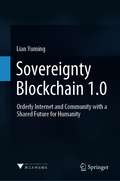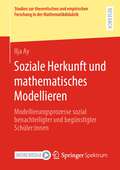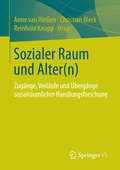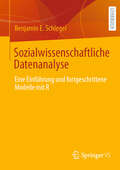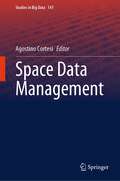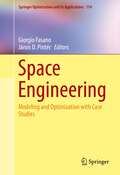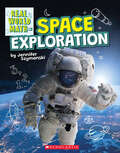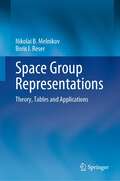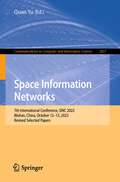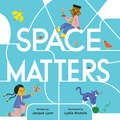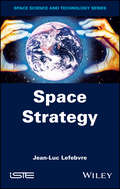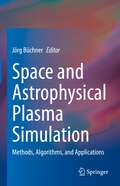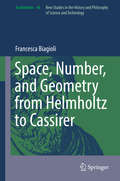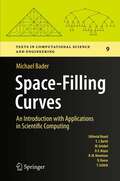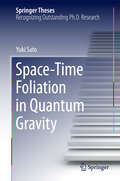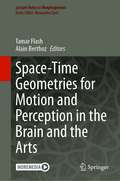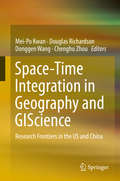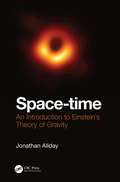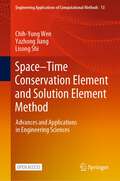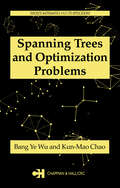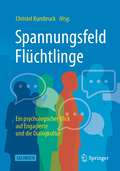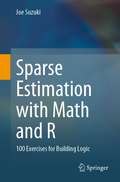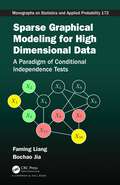- Table View
- List View
South Carolina Performance Coach, Mathematics, [Grade] 6
by Triumph Learning LlcNIMAC-sourced textbook
Sovereignty Blockchain 1.0: Orderly Internet and Community with a Shared Future for Humanity
by Lian YumingThis book presents a general framework analysis of sovereignty in blockchain based on the concept of blockchain technology, and specifically discusses the three theoretical foundations of sovereignty in blockchain: data sovereignty theory, social trust theory, and smart contract theory. It also explores the evolution of laws concerning data and digital rights, how to build trust mechanisms for digital rights transactions, as well as contract signing and the implementation of digital rights transactions.
Soziale Herkunft und mathematisches Modellieren: Modellierungsprozesse sozial benachteiligter und begünstigter Schüler:innen (Studien zur theoretischen und empirischen Forschung in der Mathematikdidaktik)
by Ilja AySoziale Ungleichheit im Bildungswesen stellt eine wesentliche Herausforderung moderner Gesellschaften dar. Zusammenhänge zwischen der sozialen Herkunft von Schüler:innen und ihrer Mathematikleistung können statistisch vielfach nachgewiesen werden. Ebenso legen zahlreiche Studien nahe, dass das System Schule dazu tendiert, die außerschulischen Handlungslogiken sozial benachteiligter Personen als defizitärer einzustufen. Gerade beim Umgang mit Modellierungsaufgaben, d.h. realitätsnahen und offenen Problemen, können die außerschulischen Logiken von Schüler:innen wirksam werden. Die Bedeutung mathematischen Modellierens für soziale Ungleichheit wird dabei in der Literatur kontrovers diskutiert. Diese qualitativ angelegte Forschungsstudie untersucht auf Grundlage von Bourdieus Konzepten Mechanismen sozialer Ungleichheit beim Modellieren aus einer bildungssoziologischen Perspektive, die die Verfügbarkeit von Ressourcen und die häusliche Sozialisation von Schüler:innen in den Blick nimmt. Diskutiert werden Auffälligkeiten, die sich beim Bearbeiten von Modellierungsaufgaben bei Schüler:innen unterschiedlicher sozialer Herkunft zeigen. Damit soll insgesamt ein Beitrag dazu geleistet werden, Herausforderungen und Potentiale mathematischen Modellierens für einen sozial gerechteren Unterricht zu diskutieren.
Sozialer Raum und Alter(n)
by Anne Van Rießen Christian Bleck Reinhold KnoppDie zunehmende Alterung der Gesellschaft hat in den vergangenen Jahren dazu geführt, dass sozialräumliche Voraussetzungen und Perspektiven älterer Menschen stärker in den Fokus sozialpolitischer, städtebaulicher und wissenschaftlicher Diskurse gerückt sind. In diesem Sammelband werden die Schwerpunktthemen Sozialer Raum und Alter(n) anhand ausgewählter theoretischer Grundlagen und aktueller Forschungsprojekte - unter den Kategorien Zugänge, Verläufe und Übergänge - dargestellt und kritisch diskutiert.
Sozialwissenschaftliche Datenanalyse: Eine Einführung und fortgeschrittene Modelle mit R
by Benjamin E. SchlegelSozialwissenschaftliche Analyseverfahren helfen uns, Daten richtig zu verstehen und fundierte Schlüsse zu ziehen. Dieses Lehrbuch bietet eine schrittweise Einführung in die Grundlagen der Datenanalyse. Es beginnt mit deskriptiven Analysen, führt über lineare Regressionen und behandelt anschließend weiterführende, komplexere statistische Modelle. Mithilfe des frei verfügbaren Statistikprogramms R werden die Analysen anschaulich umgesetzt, um die theoretischen Konzepte greifbarer zu machen. Zusätzlich stellt der Autor Quarto Markdown vor – ein Werkzeug, das das Erstellen von Seminar-, Bachelor- und Masterarbeiten auf technischer Ebene erheblich erleichtert. Übungen am Ende der Kapitel fördern die Anwendung und Vertiefung des Gelernten. Dieses Buch richtet sich primär an Studierende der Sozialwissenschaften.
Space Data Management (Studies in Big Data #141)
by Agostino CortesiThe book presents latest results pertaining to challenges faced by researchers in space data management. There are large number of highly important applications that currently rely upon data from satellites and space missions, ranging from weather prediction to monitoring of environmental pollution, climate change, marine traffic, agriculture, and urban planning, etc. The quality and quantity of space data poses new and specific challenges to the scientific community, covering the entire life cycle of space data management and with a need for an interdisciplinary approach. The chapters written by experts discusses impacts of these challenges, and report activities that can stimulate new research.
Space Engineering: Modeling and Optimization with Case Studies (Springer Optimization and Its Applications #114)
by Giorgio Fasano János D. PintérThis book presents a selection of advanced case studies that cover a substantial range of issues and real-world challenges and applications in space engineering. Vital mathematical modeling, optimization methodologies and numerical solution aspects of each application case study are presented in detail, with discussions of a range of advanced model development and solution techniques and tools.Space engineering challenges are discussed in the following contexts: •Advanced Space Vehicle Design•Computation of Optimal Low Thrust Transfers•Indirect Optimization of Spacecraft Trajectories•Resource-Constrained Scheduling,•Packing Problems in Space•Design of Complex Interplanetary Trajectories•Satellite Constellation Image Acquisition•Re-entry Test Vehicle Configuration Selection•Collision Risk Assessment on Perturbed Orbits•Optimal Robust Design of Hybrid Rocket Engines•Nonlinear Regression Analysis in Space Engineering•Regression-Based Sensitivity Analysis and Robust Design•Low-Thrust Multi-Revolution Orbit Transfers•Modeling and Optimization of Balance Layout Problems•Pilot-Induced Oscillations Alleviation•Modeling and Optimization of Hybrid Transfers to Near-Earth Objects•Probabilistic Safety Analysis of the Collision Between Space Debris and Satellite•Flatness-based Low-thrust Trajectory Optimization for Spacecraft Proximity Operations The contributing authors are expert researchers and practitioners in either the space engineering and/or in the applied optimization fields. Researchers and practitioners working in various applied aspects of space engineering will find this book practical and informative. Academics, graduate and post-graduate students in aerospace engineering, applied mathematics, operations research, optimization, and optimal control, will find this book useful.
Space Exploration (Real World Math)
by Jennifer SzymanskiGrab your space suit and get ready to use math to explore space!3 … 2 … 1 … blast off! Space scientists use math every day to explore our universe. Join a real astronomer on an amazing adventure to COUNT the planets, MEASURE the stars, ADD on the space station, and more. Then test your math skills with special You Can Do It challenges.This brand-new series demonstrates how math skills can be applied to high-interest topics and careers in Coding, Building, Tracking Animals, and Space Exploration. The K-2 math concepts include counting 1-100 with basic addition and subtraction, using the power of 10, measuring, and simple geometry. Real world scientists, architects, programmers, and mathematicians model hands-on, from-the-field experiences in a way that will make children excited to use and expand their math skills!
Space Group Representations: Theory, Tables and Applications
by Nikolai B. Melnikov Boris I. ReserThis book is devoted to the construction of space group representations, their tabulation, and illustration of their use. Representation theory of space groups has a wide range of applications in modern physics and chemistry, including studies of electron and phonon spectra, structural and magnetic phase transitions, spectroscopy, neutron scattering, and superconductivity. The book presents a clear and practical method of deducing the matrices of all irreducible representations, including double-valued, and tabulates the matrices of irreducible projective representations for all 32 crystallographic point groups. One obtains the irreducible representations of all 230 space groups by multiplying the matrices presented in these compact and convenient to use tables by easily computed factors. A number of applications to the electronic band structure calculations are illustrated through real-life examples of different crystal structures. The book's content is accessible to both graduate and advanced undergraduate students with elementary knowledge of group theory and is useful to a wide range of experimentalists and theorists in materials and solid-state physics.
Space Information Networks: 7th International Conference, SINC 2023, Wuhan, China, October 12–13, 2023, Revised Selected Papers (Communications in Computer and Information Science #2057)
by Quan YuThis book constitutes revised selected papers from the thoroughly refereed proceedings of the 7th International Conference on Space Information Network, SINC 2023, held in Wuhan, China, during October 12–13, 2023. The 8 full papers and 5 short papers included in this book were carefully reviewed and selected from 73 submissions. The papers present the latest research in the fields of space information networks.
Space Matters
by Jacque LynnGently encourage mindfulness and critical thinking through this playful and witty exploration of negative space. Can empty space be useful? Can it lead to new perspectives and new appreciation? Might it even be inspiring? Find out in a winsome book that draws on a child&’s everyday experiences to prompt readers to look twice at their surroundings and notice the significance of sights, sounds, and spaces otherwise taken for granted.
Space Strategy
by Jean-Luc Lefebvre"If there has not been a war in space, there is already more war without space!" To understand the spatial strategy, we must first know the environment and delineate the field. It must then assess the strategic importance of space. Finally, we must imagine the possibilities of a fight since, against and in space. Space Strategy responds to this questioning. Moreover, this book explicitly established concepts, such as the militarization and weaponization of space; it innovates by setting the "martialisation of space". It shows how space assets are a key component of information literacy, the key to power in the next century. Finally, it sets out a number of principles and lays the foundation for a future strategy and using the Moon Lagrange points.
Space and Astrophysical Plasma Simulation: Methods, Algorithms, and Applications
by Jörg BüchnerThis book is a collection of contributions covering the major subjects in numerical simulation of space and astrophysical plasma. It introduces the different approaches and methods to model plasma, the necessary computational codes, and applications in the field. The book is rooted in the previous work Space Plasma Simulation (Springer, 2003) and includes the latest developments. It is divided into three parts and all chapters start with an introduction motivating the topic and its use in research and ends with a discussion of its applications. The chapters of the first part contain tutorials of the different basic approaches needed to perform space plasma simulations. This part is particularly useful for graduate students to master the subject. The second part presents more advanced materials for students and researchers who already work with pre-existing codes but want to implement the recent progresses made in the field. The last part of the book discusses developments in the area for researchers who are actively working on advanced simulation approaches like higher order schemes and artificial intelligence, agent-based technologies for multiscale and multi-dimensional systems, which represent the recent innovative contributions made in space plasma research.
Space, Number, and Geometry from Helmholtz to Cassirer
by Francesca BiagioliThis book offers a reconstruction of the debate on non-Euclidean geometry in neo-Kantianism between the second half of the nineteenth century and the first decades of the twentieth century. Kant famously characterized space and time as a priori forms of intuitions, which lie at the foundation of mathematical knowledge. The success of his philosophical account of space was due not least to the fact that Euclidean geometry was widely considered to be a model of certainty at his time. However, such later scientific developments as non-Euclidean geometries and Einstein's general theory of relativity called into question the certainty of Euclidean geometry and posed the problem of reconsidering space as an open question for empirical research. The transformation of the concept of space from a source of knowledge to an object of research can be traced back to a tradition, which includes such mathematicians as Carl Friedrich Gauss, Bernhard Riemann, Richard Dedekind, Felix Klein, and Henri Poincaré, and which finds one of its clearest expressions in Hermann von Helmholtz's epistemological works. Although Helmholtz formulated compelling objections to Kant, the author reconsiders different strategies for a philosophical account of the same transformation from a neo-Kantian perspective, and especially Hermann Cohen's account of the aprioricity of mathematics in terms of applicability and Ernst Cassirer's reformulation of the a priori of space in terms of a system of hypotheses. This book is ideal for students, scholars and researchers who wish to broaden their knowledge of non-Euclidean geometry or neo-Kantianism.
Space-Filling Curves
by Michael BaderThe present book provides an introduction to using space-filling curves (SFC) as tools in scientific computing. Special focus is laid on the representation of SFC and on resulting algorithms. For example, grammar-based techniques are introduced for traversals of Cartesian and octree-type meshes, and arithmetisation of SFC is explained to compute SFC mappings and indexings. The locality properties of SFC are discussed in detail, together with their importance for algorithms. Templates for parallelisation and cache-efficient algorithms are presented to reflect the most important applications of SFC in scientific computing. Special attention is also given to the interplay of adaptive mesh refinement and SFC, including the structured refinement of triangular and tetrahedral grids. For each topic, a short overview is given on the most important publications and recent research activities.
Space-Time Foliation in Quantum Gravity
by Yuki SatoIn this thesis, the author considers quantum gravity to investigate the mysterious origin of our universe and its mechanisms. He and his collaborators have greatly improved the analyticity of two models: causal dynamical triangulations (CDT) and n-DBI gravity, with the space-time foliation which is one common factor shared by these two separate models. In the first part, the analytic method of coupling matters to CDT in 2-dimensional toy models is proposed to uncover the underlying mechanisms of the universe and to remove ambiguities remaining in CDT. As a result, the wave function of the 2-dimensional universe where matters are coupled is derived. The behavior of the wave function reveals that the Hausdorff dimension can be changed when the matter is non-unitary. In the second part, the n-DBI gravity model is considered. The author mainly investigates two effects driven by the space-time foliation: the appearance of a new conserved charge in black holes and an extra scalar mode of the graviton. The former implies a breakdown of the black-hole uniqueness theorem while the latter does not show any pathological behavior.
Space-Time Geometries for Motion and Perception in the Brain and the Arts (Lecture Notes in Morphogenesis)
by Alain Berthoz Tamar FlashThis book is based on a two-day symposium at the Paris Institute of Advanced Study titled "space-time geometries and movement in the brain and the arts". It includes over 20 chapters written by the leading scientists and artists who presented their related research studies at the symposium and includes six sections; the first three focus on space-time geometries in perception, action and memory while the last three focus on specific artistic domains: drawing and painting, dance, music, digital arts and robotics. The book is accompanied by a dedicated webpage including related images and videos. There is an ever-growing interest in the topics covered by this book. Space and time are of fundamental importance for our understanding of human perception, action, memory and cognition, and are entities which are equally important in physics, biology, neuroscience and psychology. Highly prominent scientists and mathematicians have expressed their belief that our bodies and minds shape the ways we perceive space and time and the physical laws we formulate. Understanding how the brain perceives motion and generates -bodily movements is of great significance. There is also growing interest in studying how space, time and movement subserve artistic creations in different artistic modalities (e.g., fine arts, digital and performing arts and music). This interest is inspired by the idea that artists make intuitive use of the principles and simplifying strategies used by the brain in movement generation and perception. Building upon new understanding of the spatio-temporal geometries subserving movement generation and perception by the brain we can start exploring how artists make use of such neuro --geometrical and neuro-dynamic representations in order to express artistic concepts and emotionally affect the human observers and listeners. Scientists have also started formulating new ideas of how aesthetic judgements emerge from the principles and brain mechanisms subserving motor control and motion perception.Covering novel and multidisciplinary topics, this advanced book will be of interest to neuroscientists, behavioral scientists, artificial intelligence and robotics experts, students and artists.
Space-Time Integration in Geography and GIScience
by Donggen Wang Chenghu Zhou Mei-Po Kwan Douglas RichardsonSpace-time analysis is a rapidly growing research frontier in geography, GIS, and GIScience. Advances in integrated GPS/GIS technologies, the availability of large datasets (over time and space), and increased capacity to manage, integrate, model and visualize complex data in (near) real time, offer the GIS and geography communities extraordinary opportunities to begin to integrate sophisticated space-time analysis and models in the study of complex environmental and social systems, from climate change to infectious disease transmission. This volume specifically focuses on research frontiers, comparative research, and research and application interactions in this field in the US and China, arguably the two most dynamic loci for this work today. The contributions to this book, by top researchers in China and the US, productively highlight the differences and similarities in approaches and directions for space-time analysis in the two countries. In light of the recent rapid progress in GIScience research on space-time integration in both countries, the book's focus on research frontiers in these two countries will attract great interest in both countries and in other parts of the world as well as among related disciplines. In addition, the book also explores the impact of collaborative research and publications underway in this area between the US and China and will provide an overview of these collaborative efforts and programs. This book will not only be of interest to university-based GIS researchers and students, but also to those interested in this new area of research and applications like researchers and developers in business, internet mapping and GIS and location based services (LBS).
Space-time: An Introduction to Einstein's Theory of Gravity
by Jonathan AlldayThis book, suitable for interested post-16 school pupils or undergraduates looking for a supplement to their course text, develops our modern view of space-time and its implications in the theories of gravity and cosmology. While aspects of this topic are inevitably abstract, the book seeks to ground thinking in observational and experimental evidence where possible. In addition, some of Einstein’s philosophical thoughts are explored and contrasted with our modern views. Written in an accessible yet rigorous style, Jonathan Allday, a highly accomplished writer, brings his trademark clarity and engagement to these fascinating subjects, which underpin so much of modern physics. Features: Restricted use of advanced mathematics, making the book suitable for post-16 students and undergraduates Contains discussions of key modern developments in quantum gravity, and the latest developments in the field, including results from the Laser Interferometer Gravitational-Wave Observatory (LIGO) Accompanied by appendices on the CRC Press website featuring detailed mathematical arguments for key derivations
Space–Time Conservation Element and Solution Element Method: Advances and Applications in Engineering Sciences (Engineering Applications of Computational Methods #13)
by Chih-Yung Wen Yazhong Jiang Lisong ShiThis open access book introduces the fundamentals of the space–time conservation element and solution element (CESE) method, which is a novel numerical approach for solving equations of physical conservation laws. It highlights the recent progress to establish various improved CESE schemes and its engineering applications. With attractive accuracy, efficiency, and robustness, the CESE method is particularly suitable for solving time-dependent nonlinear hyperbolic systems involving dynamical evolutions of waves and discontinuities. Therefore, it has been applied to a wide spectrum of problems, e.g., aerodynamics, aeroacoustics, magnetohydrodynamics, multi-material flows, and detonations. This book contains algorithm analysis, numerical examples, as well as demonstration codes. This book is intended for graduate students and researchers who are interested in the fields such as computational fluid dynamics (CFD), mechanical engineering, and numerical computation.
Spaghetti and Meatballs for All!: A Mathematical Story
by Debbie Tilley Marilyn BurnsKids will exercise their early math skills with this bestselling picture book--now available in Scholastic Bookshelf! Mr. and Mrs. Comfort are having a family reunion! Mr. Comfort starts cooking up his famous spaghetti and meatballs, while Mrs. Comfort carefully arranges eight tables and thirty-two chairs so that everyone will have a seat. The tables look lovely, the food is ready, and here come the guests--with their own seating plans! This delightful Marilyn Burns Brainy Day Book uses wit and humor to draw children into thinking about area and perimeter.
Spanning Trees and Optimization Problems (Discrete Mathematics and Its Applications)
by Bang Ye Wu Kun-Mao ChaoThe design of approximation algorithms for spanning tree problems has become an exciting and important area of theoretical computer science and also plays a significant role in emerging fields such as biological sequence alignments and evolutionary tree construction. While work in this field remains quite active, the time has come to collect under
Spannungsfeld Flüchtlinge: Ein psychologischer Blick auf Engagierte und die Dialogkultur
by Christel KumbruckDieses Buch analysiert wissenschaftlich fundiert und zugleich allgemeinverständlich das Engagement von Menschen, die sich für die Aufnahme von Geflüchteten oder gegen die deutsche Flüchtlingspolitik engagieren, sowie ihre Motive, Emotionen, Denk- und Argumentationsweisen. Dabei werden psychologische Mechanismen, die ursächlich für die viel diskutierte Polarisierung unserer modernen Gesellschaft sind, deutlich. Erstmalig werden die tieferen Ursachen für bestehende Dialogbarrieren aufgespürt und mit psychologischen Modellen erklärt. Dabei decken die Autor*innen neben polarisierenden Dialogprozessen auch Gemeinsamkeiten beider Seiten auf und erarbeiten daraus Ansatzpunkte für Dialogchancen und eine Depolarisierung der Kommunikation. Neben der psychologischen Betrachtung erfolgt außerdem eine Einordung der beschriebenen, empirisch ermittelten Erkenntnisse in übergeordnete soziokulturelle Prozesse und gesellschaftliche Rahmenbedingungen. Auch hieraus werden Lösungsansätze, diesmal auf der Ebene von Politik und Gesellschaft, erarbeitet. Ein Buch für alle, die mehr Einblicke in das Flüchtlingsengagement haben wollen, die sich in Politik, Beratung, Coaching, Erziehung u.ä. aktiv an der Bewahrung einer Dialogkultur beteiligen, oder zumindest die (psychologischen) Mechanismen verstehen möchten, welche eine Polarisierung der Gesellschaft fördern."Dieses klare und differenzierte Arbeitsbuch ist eine großartige Hilfe zum Selbstdenken." - Prof. Aleida Assmann"Flucht und Migration werden Deutschland weiterhin vor Herausforderungen stellen. Dieses Buch zeigt nachvollziehbar, wie Wahrnehmungs-, Denk- und Handlungsweisen zu einer destruktiven Polarisierung beitragen können, aber auch welche Möglichkeiten wir alle haben, um der Falle vergifteter Kommunikation zu entgehen: ein hilfreiches Buch, um demokratischen Zusammenhalt zu stärken." - Prof. Eva Senghaas-Knobloch
Sparse Estimation with Math and R: 100 Exercises for Building Logic
by Joe SuzukiThe most crucial ability for machine learning and data science is mathematical logic for grasping their essence rather than knowledge and experience. This textbook approaches the essence of sparse estimation by considering math problems and building R programs. Each chapter introduces the notion of sparsity and provides procedures followed by mathematical derivations and source programs with examples of execution. To maximize readers’ insights into sparsity, mathematical proofs are presented for almost all propositions, and programs are described without depending on any packages. The book is carefully organized to provide the solutions to the exercises in each chapter so that readers can solve the total of 100 exercises by simply following the contents of each chapter.This textbook is suitable for an undergraduate or graduate course consisting of about 15 lectures (90 mins each). Written in an easy-to-follow and self-contained style, this book will also be perfect material for independent learning by data scientists, machine learning engineers, and researchers interested in linear regression, generalized linear lasso, group lasso, fused lasso, graphical models, matrix decomposition, and multivariate analysis.This book is one of a series of textbooks in machine learning by the same author. Other titles are: - Statistical Learning with Math and R (https://www.springer.com/gp/book/9789811575679) - Statistical Learning with Math and Python (https://www.springer.com/gp/book/9789811578762) - Sparse Estimation with Math and Python
Sparse Graphical Modeling for High Dimensional Data: A Paradigm of Conditional Independence Tests (Chapman & Hall/CRC Monographs on Statistics and Applied Probability)
by Faming Liang Bochao JiaThis book provides a general framework for learning sparse graphical models with conditional independence tests. It includes complete treatments for Gaussian, Poisson, multinomial, and mixed data; unified treatments for covariate adjustments, data integration, and network comparison; unified treatments for missing data and heterogeneous data; efficient methods for joint estimation of multiple graphical models; effective methods of high-dimensional variable selection; and effective methods of high-dimensional inference. The methods possess an embarrassingly parallel structure in performing conditional independence tests, and the computation can be significantly accelerated by running in parallel on a multi-core computer or a parallel architecture. This book is intended to serve researchers and scientists interested in high-dimensional statistics, and graduate students in broad data science disciplines. Key Features: A general framework for learning sparse graphical models with conditional independence tests Complete treatments for different types of data, Gaussian, Poisson, multinomial, and mixed data Unified treatments for data integration, network comparison, and covariate adjustment Unified treatments for missing data and heterogeneous data Efficient methods for joint estimation of multiple graphical models Effective methods of high-dimensional variable selection Effective methods of high-dimensional inference

